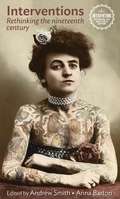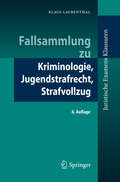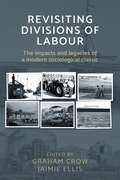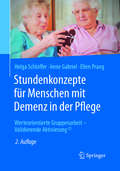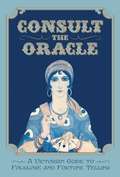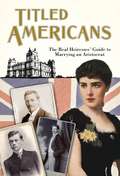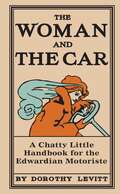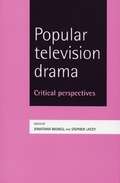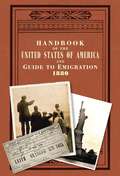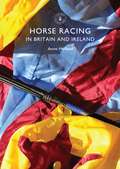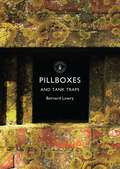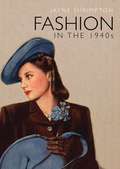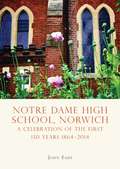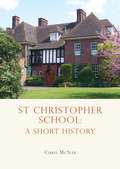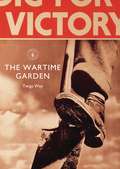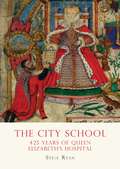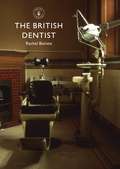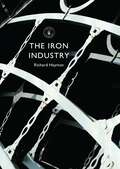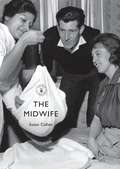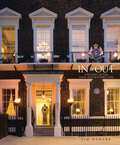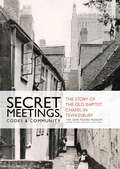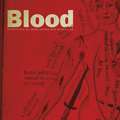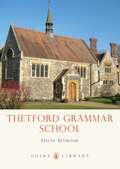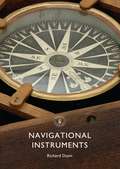- Table View
- List View
Interventions: Rethinking the nineteenth century (Interventions: Rethinking the Nineteenth Century,inventions rethinking nineteenth century)
by Andrew Smith Anna BartonThis book aims to intervene in current critical contexts for the study of nineteenth-century literature within the academy and beyond. Topics discussed include science and technology, poetry and philosophy, the Gothic, anatomical exhibitions, the global spread of liberalism, Anglo-American publishing, Punjabi popular culture and the neo-Victorian in literature, film and performance. By bringing together a broad range of intellectually challenging perspectives, the book offers an engaging critical overview of the field of nineteenth-century literary studies that will appeal both to scholars working within the field and students and teachers encountering this fascinating area of study for the first time.
Fallsammlung zu Kriminologie, Jugendstrafrecht, Strafvollzug (Juristische ExamensKlausuren)
by Klaus LaubenthalDiese Sammlung von zwölf Klausuren aus den drei Fächern Kriminologie, Jugendstrafrecht, Strafvollzug behandelt exemplarisch relevante Fragestellungen und Problembereiche. Sie dient der Wiederholung und Ergänzung des durch Besuch von Lehrveranstaltungen und der Lektüre einschlägiger Lehrbücher erworbenen Wissens und soll die gewonnenen Erkenntnisse vertiefen. Großen Wert hat der Autor auf einen lernspezifischen Zuschnitt der Fallsammlung gelegt. Dieser bezweckt nicht nur die Wiederholung und Ergänzung von Basiswissen, sondern vermittelt auch formale Gesichtspunkte, die an eine Klausur, Haus- bzw. Studienarbeit oder eine sonstige Falllösung zur Erlangung eines Leistungsnachweises zu stellen sind. Die 6. Auflage ist neu bearbeitet. Sie berücksichtigt alle Neuregelungen wie diejenigen der Strafvollzugsgesetze sowie solche im Bereich des Opferschutzes.
Revisiting Divisions of Labour: The impacts and legacies of a modern sociological classic
by Graham Crow Jaimie EllisThis collection revisits Ray Pahl's 1984 sociology classic, combining excerpts from the original with assessments by leading researchers of how and why the book has stood the test of time as a study that fundamentally re-thinks our understanding of 'work'.
Stundenkonzepte für Menschen mit Demenz in der Pflege: Werteorientierte Gruppenarbeit - Validierende Aktivierung©
by Helga Schloffer Irene Gabriel Ellen PrangBeschäftigung, Aktivierung und Lebensqualität für Menschen mit DemenzDas Praxisbuch für Gruppenleitende in der Demenzbetreuung bietet über 20 komplett vorbereitete Stundenkonzepte zu unterschiedlichen Lebensthemen, wie z.B. Familie, Natur, Feste, Kindheit, Essen, Arbeit. Durch die detaillierte Anleitung der einzelnen Beschäftigungsstunden benötigt die Gruppenleitung kaum Vorkenntnisse und kann sofort passende Stundenkonzepte praktisch durchführen. Die neuartige Methode der Validierenden Aktivierung wurde aus der Praxis heraus entwickelt underleichtert nicht nur die Kommunikation mit demenzerkrankten Menschen, sondern stärkt auch die Lebensqualität. Es ermöglicht die Wahrnehmung des Menschen mit Demenz als Person – mit seiner Lebensgeschichte, seinen Fähigkeiten und Emotionen.Aus dem InhaltDetaillierte Stundenkonzepte begleiten Schritt für Schritt durch die GruppenstundeTipps zum Einstieg in das StundenthemaVorschläge für Gegenstände, Lieder u.v.m. Hinweise, welche Ressourcen gefördert werden Eine hilfreiche Ideensammlung für Altenpflegerinnen und Gruppenleitungen in Pflegeeinrichtungen, Tagesgruppen und anderen Betreuungsangeboten für Menschen mit Demenz.
Consult the Oracle: A Victorian Guide to Folklore and Fortune Telling
by Gabriel Nostradamus"If you sing before breakfast you will cry before supper...' In their own words, what it meant for Victorians to dream of actors, April Fools, herrings or a railway ticket – why it was advised to throw a black snail by its horns over the left shoulder for good luck – and why it is essential to inform bees of a death in the family. "If one drops a knife, a woman is coming; a fork, a man is coming; a spoon, a fool.†? Tappings on tables, questionable curatives, old wives' tales and whispers from beyond the grave – Victorians were fascinated by the supernatural. Consult the Oracle was where they might have turned when they needed to identify a witch, interpret an omen or dream, required a natural cure or wanted to divine their future with a pack of cards – or simply wished to understand what the supernatural meant to them and their ancestors. First published in 1899, it offered a layman's guide to 'matters magical and mysterious', and today is a quirky glimpse of a supernatural age now lost, by turns haunting and hilarious.
Titled Americans, 1890: A list of American ladies who have married foreigners of rank
by Chauncey M DepewPerfect for all Downton Abbey fans, this is the 1890 book behind the marriage of Lord and Lady Grantham. In an age when securing a prudent match was all-important for both sexes, Titled Americans offered a glance guide to recent high society marriages and a list of eligible bachelors who were still on the lookout for love. It explores and explains the trend for well-heeled European gents selecting American wives, discusses the relative merits of attaching oneself to an American or an English girl (†?the American girl comes along, prettier than her English sister, dazzling and audacious, and she is a revelation to the Englishman†?), and examines in detail the various titled families of Europe. Included to "arouse the ambition of the American girl†?, there is a list of unmarried English Peers, making this a fantastic glimpse of the stately homes, relative fortunes and social lives of the glamorous English and American upper-classes at the turn of the century.
Arthur Murray’s Popularity Book: Vintage Advice and Wisdom from The Greatest Generation
by Arthur MurrayFIRST PUBLISHED IN 1944, the Popularity Book is a vintage guidebook full of wise and wonderful advice on living well, building poise and maintaining good relationships. Drawing on books, testimonials and magazines from the World War II era, it shows the forthright common sense and charming romanticism of the "Greatest Generation†?, a generation inspired by debonair role models such as Clark Gable, Cary Grant and Katharine Hepburn. As relevant today as it was in the 1940s, the Popularity Book offers counsel on being an unforgettably great date, eliciting a marriage proposal, and how to be generally charming. Compiled and originally published by Arthur Murray, it also features his iconic step-by-step footprint instructions on how to Samba, Fox Trot and Rumba divinely!
The Woman and the Car: A Chatty Little Handbook for the Edwardian Motoriste (Old House Ser.)
by Dorothy LevittThe Woman and the Car is a faithfully reproduced, quirky classic from the dawn of motoring – and testament to womankind's perennial claim on the steering wheel! Take a spin through a time – 1909, to be precise – when no right-thinking lady would consider solo motoring without her revolver, and when the installation of a secret compartment for powder-puff was de rigeur. In the vintage driver's seat of this 'chatty little handbook' is record-breaking Edwardian motoriste Dorothy Levitt, exhorting the budding 'lady driver' to approach the newfangled contraption without fear and reassuring those who believed it was 'impossible to look anything but hideous when in an automobile.'
Popular television drama: Critical perspectives
by Jonathan Bignell Stephen LaceyA collection of essays that examine landmark popular television drama from the last forty years, from 'Doctor Who' to 'The Office'. Contributors focus on programmes across the range of popular genres, from sitcoms to science fiction, gothic horror and children's drama
Handbook of the United States of America, 1880: A Guide to Emigration
by Lp BrockettMillions of immigrants entered America's "golden door†? in the years after 1880. This authentically reproduced Handbook of the United States was a trusted resource that told them everything they needed to know as they strove to become Americans. America's "golden door†? welcomed a huge wave of European immigrants between the 1880s and the 1920s. Millions passed through the gateway of the Statue of Liberty and Ellis Island on their way to becoming Americans, and The Handbook of the United States is an authentic reproduction of one of the immigrants' most trusted resources- a complete guide to the USA, including everything from the pay-rates of various trades to amusing statistics about what Americans ate, drank, and manufactured. Once the tool that helped thousands of Irish, Italian and Jewish immigrants use their drive and industriousness to succeed, today it provides new insights into the extraordinary circumstances of the immigrant experience and the new arrivals' remarkable contribution to making America a great global power.
Horse Racing in Britain and Ireland (Shire Library)
by Anne HollandOften called the sport of kings, horse racing dates back at least to the chariot races of the ancient Olympic Games. Arriving in Britain with the Romans in the first century BC, its popularity among the elite led to the breeding of thoroughbred racehorses and prompted the establishment of a formal racing calendar with flat races and steeple chases at a plethora of dedicated racecourses throughout the country. Now no longer restricted to the aristocracy, a day at the races has become a perennial highlight of the social calendar. Shedding new light on this increasingly popular equestrian sport, Anne Holland here explores the broad history of horse racing from the horses, jockeys and racecourses to the practice of bookmaking and those in the audience.
Pillboxes and Tank Traps (Shire Library)
by Bernard LowryWith invasion a very real threat, in 1940 Great Britain began a huge military construction programme designed to stop an invading army in its tracks. Around vulnerable coastlines, and inland, thousands of pillboxes, anti-tank barriers and other obstacles were erected to defend against attacks from sea and sky. Though many of these structures were dismantled in the wake of the Second World War, the coast and even some inland areas still boast a wealth of fascinating remains; in this fully illustrated introduction, fortifications authority Bernard Lowry guides the inquiring reader in identifying these remaining defensive structures and explains their seemingly 'random' placement across the British landscape.
Fashion in the 1940s (Shire Library)
by Jayne ShrimptonThis book reveals the impact of wartime and austerity on British fashion and tells the story of how a spirit of patriotism and make-do-and-mend unleashed a wave of new creativity among women who were starved of high fashion by shortages and rationing. Many home dressmakers copied the high-end looks, and women involved in war work created a whole new aesthetic of less formal street wear. Fashion in the 1940s also shows how the Second World War shifted the centre of the international couture scene away from Paris, allowing British designers to influence Home Front style. Afterwards Paris fashion was re-born with Dior's extravagant New Look, while casual American trends were widely adopted by young British women and men.
Notre Dame High School, Norwich: A celebration of the first 150 years 1864–2014
by John EadyFor a century and a half Notre Dame High School has occupied a central position in Norwich, and within the Roman Catholic community of East Anglia. This book traces the school's founding, the development of the school site, its transition from a Catholic convent with a day and boarding school to a direct grant girls' grammar school, through to its becoming a mixed comprehensive and today's academy. Drawing on the school's archive, and the memories and experiences of past and present pupils and staff, a vivid picture emerges of an energetic and progressive school that continues to build on the values of its founding Sisters. This book will appeal to all members of the Notre Dame community, and to anyone with a passing interest in education and the history of Catholicism in East Anglia.
St Christopher School: A Short History
by Chris McNabIn 1915 a new school opened in Letchworth. Based upon Theosophic values, it offered a very progressive form of education, with children encouraged to develop their own personal interests, and emphasis placed on tolerance towards all races and religions, and physical health and well-being. Discipline was largely self-imposed and students were able to influence the running of the school. The school's philosophy has enabled it to weather a century of change, including two world wars, economic depressions, and many shifts in national education policy. St Christopher School is now a unique and dynamic school where education continues to be based upon the concept of treating children as individuals. This book explores the school's history and philosophy, offering a concise but fascinating insight into the first hundred years of St Chris.
The Wartime Garden: Digging for Victory (Shire Library)
by Twigs WayThis War is a Food War…' In 1941 Lord Woolton, Minister for Food, was determined that the Garden Front would save England: 'Dig for Victory' was the slogan, digging for dinner the reality. With food imports dwindling the number of allotments grew, millions opted to 'Spend an Hour with a Hoe' instead of an hour in a queue, and the upper classes turned lawns, tennis courts and stately gardens over to agriculture. The national diet was transformed, with swedes grown in the place of oranges and hapless children sucking on carrot lollies; evacuees grew their own meals and bomb sites sprouted allotments. Vegetables ruled the airwaves with Mr Middleton's 'In Your Garden' whilst Home Guard potatoes became the favourites of the Kitchen Front. This is a fully illustrated look at the time when gardening saved Britain.
The City School: 425 years of Queen Elizabeth’s Hospital
by Steve RyanQEH opened in 1590 in line with the instructions laid down in John Carr's will of 1586. Always known as the City School, it has occupied three sites in and around the centre of Bristol. The current site in Berkeley Place was opened in 1847. In its 425th anniversary year, the school has 570 senior boys and over 100 boys in the Junior School and is rightly marketed as Bristol's Best Boys' School. The founder and the other historic benefactors would be very proud of the school as it exists today, as wherever possible it maintains its charitable traditions whilst at the same time providing a first class modern education.
The British Dentist (Shire Library)
by Rachel BairstoThough the prospect may fill us with dread, most of us need dental treatment at some stage – and the reality is that better care has never been available, as this fully illustrated book shows. Early dentistry was amateurish and limited to barber-surgeons, travelling tooth-pullers and blacksmiths, with patients often suffering as much from the cure as the malady; and even as things improved in the eighteenth century, fashionable dentures were still made from the teeth of dead soldiers or even of the poor. This authoritative introduction looks at this whole grisly history as well as at the increasing professionalism seen from the late nineteenth century onwards, which has led to very dramatic improvements in dental treatment, including modern dentures, amalgam fillings, anaesthetics and orthodontics, and to the current boom in cosmetic dentistry.
The Iron Industry (Shire Library)
by Richard HaymanThe iron industry was the catalyst for the Industrial Revolution, producing a vital source of iron without which none of the great engineering achievements of the Victorian age would have been possible. This book charts the growth of iron making from the Middle Ages, covering the importation of blast-furnace methods in the fifteenth century, the adoption of coke as a fuel in the eighteenth century, and the invention of mass-produced steel in the nineteenth century. The developing techniques of iron making, all explained in a non-technical style, make a story in their own right, but combined with the experiences of the masters and workmen who laboured at the furnaces and forges, this volume offers a truly comprehensive account of one of the most important industries of recent centuries.
The Midwife (Shire Library)
by Susan CohenThe midwife: medical professional, friend in a woman's hour of greatest need, potent social and cultural symbol. Though the role of midwife has existed since time immemorial, it is only since the Victorian era that it has been a recognised and regulated profession. This book, from social history expert Susan Cohen, looks at midwifery in Britain from ancient times up to the present, paying particular attention to its incredible medical and social advances of the last 150 years. It is a fully illustrated tour that takes in fictional midwives such as Dickens' Sarey Gamp, the founding of the Royal College of Midwives in 1881, the Second World War, the forming of the NHS and the Central Midwives Board, and looks at the increasing medicalisation of childbirth and the countervailing trend for giving birth at home.
The In & Out: A history of the Naval and Military Club
by Tim NewarkThe Naval and Military Club – or the 'In & Out' as it is affectionately known – is one of Britain's greatest and oldest service clubs and this book tells its rich and entertaining history for the first time. Lavishly illustrated, it captures the essence of British style inside one of London's grandest clubhouses – first with a famous home in Piccadilly and now in St James's Square. Over 150 years, its members have included numerous Victoria Cross winners, triumphant generals and admirals, even bold explorers. There are intimate tales of brave soldiers and sailors – alongside a few rogues and accounts of scandalous behaviour!
Secret Meetings, Codes and Community: The story of the Old Baptist Chapel in Tewkesbury
by Jemma FowkesThe story of the Old Baptist Chapel is a fascinating tale of family life and faith, persecution and tolerance. The Chapel began life as a late-fifteenth century hall house which was later converted into a Nonconformist meeting house.Tucked away down one of Tewkesbury's famous medieval alleyways and standing in the shadow of the magnificent abbey, this hidden gem has borne witness to five hundred years of domestic and religious use.Today it stands as a reminder of a vibrant community of independent religious thinkers and their influence on the town and surrounding areas.
Blood: Reflections on what unites and divides us
by Anthony Bale David FeldmanBlood is something that all humans share: a vital force that courses through our veins – the giver of life. This book gathers together specially commissioned essays from leading scholars which reflect on the religious, historical, and medical dimensions of blood. Written for a broad audience and illustrated with full colour plates, the essays encompass history, literature, art history, religious studies and medical humanities and explore some of the most challenging issues surrounding blood and ritual. The themes covered include: blood in Christian and Jewish culture, medieval antisemitism, Shakespeare's Merchant of Venice, Jewish ritual, blood and 'race', Jews and genes.
Thetford Grammar School: Fourteen Centuries of Education
by David SeymourThetford Grammar School's formation is shrouded in mystery, but it may date back as far as 631. First re-founded by the Bishop of Norwich in 1114, the school was revitalised following the dissolution of the monasteries, and firmly re-established by an Act of Parliament in 1610 and then by a new foundation document in 1876. A Girls' School was set up alongside the ancient Boys' School in 1888 and both schools spent the middle years of the twentieth century as county council grammar schools, before their re-foundation as a co-educational independent school in 1981. Written to coincide with the 450th anniversary of Thetford Grammar School's re-founding and drawing on the school's archives, David Seymour discusses four and a half centuries of governance, pupils, headteachers, ushers and assistant teachers, phases of building, and the development of the curriculum.
Navigational Instruments (Shire Library)
by Richard DunnWith over two-thirds of the globe covered by water, the ability to navigate safely and quickly across the oceans has been crucial throughout human history. As seafarers attempted longer and longer voyages from the sixteenth century onwards in search of profit and new lands, the tools of navigation became ever more sophisticated. The development of instruments over the last five hundred years has seen some revolutionary changes, spurred on by the threat of disaster at sea and the possibility of huge rewards from successful voyages. As this book shows, the solution of the infamous longitude problem, the extraordinary impact of satellite positioning and other advances in navigation have successfully brought together seafarers, artisans and scientists in search of better ways of getting from A to B and back again.
